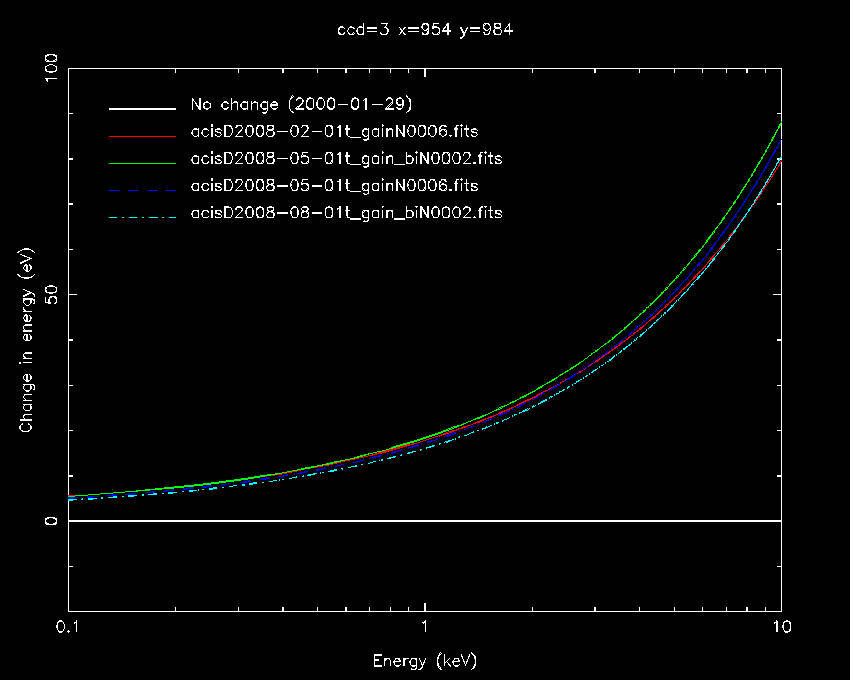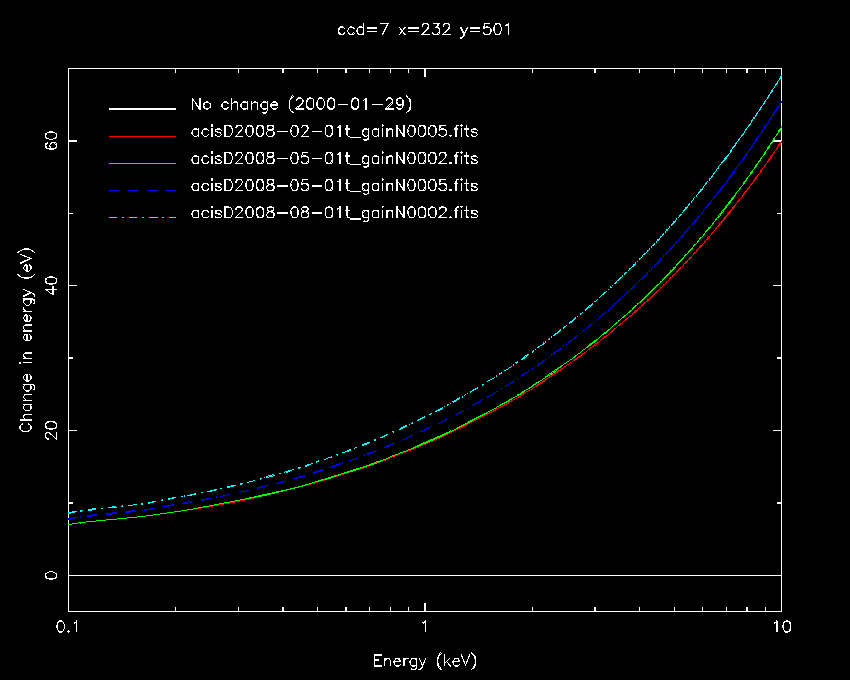CalDB PUBLIC Release Notes
Effective Date:
(UTC) 2008-12-15T17:00:00
(Not installed in SDP.)
Public Release Date: 15
December 2008
Version: 4.1.0
Release Type: PUBLIC
I. Introduction
CaldB 4.1.0 will be the first public release and official
installation of the Chandra CalDB4 directory, index, and interface
software upgrade. See the release notes for CalDB
4.0.0 for more information on the new indexing system and directory
structure. See the CIAO 4.1 release notes for further details on the
"libcaldb4" software and the calindex and calquiz tools.
CalDB 4.1.0 includes two ACIS updates:
- ACIS -120C T_GAIN Epoch 35
updates (four new files covering Epoch 34 and 35).
- ACIS -110C/-120C BI chip mkacisrmf input file for
NON-CTI-corrected data.
as well as the promulgation of the HRMA Encircled Counts Fraction
file for use in CIAO 4.1 applications for which approximate PSF sizes
are required:
- HRMA REEF version N0001. This file will be employed
specifically in the CIAO 4.1 tool "mkpsfmap." Details below.
User Documentation:
"How CalDB 4.1.0 Affects Your Analysis"
http://cxc.harvard.edu/ciao/releasenotes/ciao_4.1_release.html#HowCALDB4.1.0AffectsYourAnalysis
II. Summary of Changes
A. ACIS -120C T_GAIN Epoch 35
LOCATION: $CALDB/data/chandra/acis/t_gain/
FILENAMES: acisD2008-05-01t_gainN0005.fits
acisD2008-05-01t_gainN0006.fits
acisD2008-08-01t_gainN0002.fits
acisD2008-08-01t_gain_biN0002.fits
Epoch 35 covers the 01August through 31 October 2008 period. The T_GAIN
interpolation files effective for 2008-05-01 include both Epochs 34 and
35. The new files effective on 2008-05-01 are non-interpolating or
"flat" files including only Epoch 35. The four datasets follow the
current convention for T_GAIN
upgrades, in that the first and third files include data for S1 and S3
(the BI chips) that are NOT CTI corrected. The second and fourth files
have CTI-corrected BI chip data. For the FI data, the CTI correction is
always applied, as no
calibration for T_GAIN exists for the FI non-CTI case.
Pipes/Tools affected:
SDP/CIAO ACIS L1 processing tool "acis_process_events"
Threads affected:
"Reprocessing Data to Create a New Level=2 Event File"
http://cxc.cfa.harvard.edu/ciao/threads/createL2/
Why Topic: "ACIS Time-dependent Gain Correction (T_GAIN)"
http://cxc.harvard.edu/ciao4.0/why/acistgain.html
B. ACIS -110C & -120C BI chip P2_RESP
for mkacisrmf
LOCATION: $CALDB/data/chandra/acis/p2_resp/
FILENAME: acisD1999-09-16p2_respN0005.fits
The new file is just a handy addition to CalDB for users of GRADED mode
-120C BI chip data, as well as -110C
BI chip data where no CTI correction is currently available. The file
has all data required by mkacisrmf for the BI chips
provided
the latest DET_GAINs (ACIS gain files) are used when the data are
reprocessed. It has NO data for front illuminated
chips, so it will not deliver false RMFs for uncorrected FI chip data.
(For the FI chips when they are not CTI corrected,
the FEF_PHA files and mkrmf must be used to generate
the correct RMFs.)
Pipes/Tools affected: NONE
Thread affected:
"Creating ACIS RMFs with mkacisrmf"
http://cxc-test.harvard.edu/ciao/threads/mkacisrmf/
C. HRMA REEF version N0001 (Encircled Counts
Fraction)
LOCATION: $CALDB/data/chandra/default/reef/
FILENAME: hrmaD1996-12-20reefN0001.fits
This file provides psf encircled counts fraction data for use in the
CIAO tool "mkpsfmap." The tool is used to generate a map of the PSF-size
estimates as taken or interpolated from the REEF file data, at a
particular energy given by the user, for a particular ECF value
specified by
the user. It computes a PSF-size estimate for each pixel of an input
image.
CAVEAT: The circular ECF values in the present REEF file are
recommended for use when approximate PSF scales are needed, such as in
adaptive smoothing applications or the Catalog limiting sensitivity
tool. We do NOT recommend use of the file for detailed calculations of
off-axis PSF properties; use of MARX and SAOTrace/Chart, and comparison
with real data, is the best approach we currently have for that
purpose.
Why page:
http://cxc.harvard.edu/ciao4.1/threads/mkpsfmap/
Threads affected:
There will be a new thread, currently under development, for the CIAO
4.1 threads web pages.
III. Technical Details
A. ACIS Epoch 35 T_GAIN files
The new -120C T_GAIN data were derived from ACIS External
Calibration
Source (ECS) data taken during radiation zone passes during Aug - Oct
2008. Here are the plotted corrections, showing the changes from
the previous files and the new ones, for the aimpoint of ACIS-I3
(Figure 1). At 5 keV, the new correction is about 5-10 eV and at 10keV
the correction is 9-18 eV (0.09-0.18%), depending on the interpolation
point (DATE-OBS).

Figure 1: A comparison of old and new
T_GAIN
corrections for the CTI-corrected FI chip I3 at the aimpoint. There is
not much of change with the new files.
Likewise, below is the comparison between old and new T_GAIN
data
for the aimpoint of ACIS-S3, with the BI chip CTI correctors
applied.

Figure 2: A comparison of old and new
T_GAIN
corrections for the CTI-corrected BI chip ACIS-S3 at the
aimpoint. The changes here are minor as well, though a bit larger than
the other two illustrated cases.
Now consider the non-CTI corrected case for ACIS-S3, applied to
data
for which the CTI correction is unavailable or has not been applied to
the BI chips.

Figure 3: A comparison of old and new
T_GAIN
corrections for the non-CTI-corrected BI chip ACIS-S3 at the
aimpoint. The changes here are minor as well.
Hence the new Epoch 35 T_GAIN corrections are basically
necessary for optimal application of the time-dependent gains for the
most recent Chandra ACIS data. Hence the continued need for our period
upgrades to these data.
B. ACIS -110C - -120C P2_RESP data for mkacisrmf
The specific data released in this file are precisely and only the
relevant PRE-CTI and SCATTERING MATRIX data, along with a compatible
GAIN corrections table, as have been released for un-CTI-corrected BI
chips in the past, specifically in the CalDB file
acisD2000-01-29p2_respN0005.fits. The new -110C gains released in CalDB
3.4.3, when applied, now require the user to used these
input data and mkacisrmf for proper RMFs. The FEF_PHA data no longer
work for the BI chips with the new gains applied, whether at -110C
or -120C, again only for the non-CTI-corrected case. Hence this new
file eases the process of selecting the correct P2_RESP data for GRADED
mode or -110C BI chip data.
C. Radial Encircled Count Fraction tables (REEF2
format) for CIAO 4.1 source sensitivity and detection.
The CalDB REEF file:
hrmaD1996-12-20reefN0001.fits
is based on, and contains the data
from the
hrmaD1996-12-20hrci_ecf_N0002.fits
file with a revised file structure
(see description in the file's ICD Specification, explicitly linked at supporting/ecficd.pdf)
Note that
the explicit reference to
the HRC-I in the INSTRUME keyword is removed, as these data will be
used in ACIS Level 3 processing as well. The file contains Chandra
HRMA
PSF
parameterized as enclosed count fractions (ECF) within circular
apertures. The parameterization is given as RADIUS(ECF, THETA, PHI,
ENERGY) where ECF is a fraction of the total number of counts contained
within a given circle in a plane perpendicular to the telescope's
optical axis, THETA is the off axis angle, PHI is the azimuthal angle
(oriented in Mirror Spherical Coordinates), and ENERGY is the midpoint
of the
energy bin (with the upper and lower ENERGY bounds ENERG_LO and
ENERG_HI,
respectively).
The calculation were carried out using
rays produced by SAOsac and
the
HRMA configuration file "orbit_XRCF+tilts_04". The simulations were
generated using the flat geometry of the HRC-I.
The radii were calculated for a set of energies (midpoint of the valid
energy range), off-axis angles, azimuthal angles (oriented in Mirror
Spherical Coordinates), and a set of ECFs:
ECFs:
1% steps from 0.01 to 1
Energies (in keV):
0.5, 1.0, 1.5, 2.0, 2.5, 3.0, 3.5, 4.0, 4.5, 5.0, 5.5, 6.0, 6.5, 7.0,
7.5, 8.0, 8.5, 9.0, 9.5, 10.0
Off axis angles (in arcminutes):
0.15, 0.25, 1.0, 1.5, 2.0, 3.0, 5.0, 7.5, 10.0, 12.5, 17.0, 20.0
Azimuthal angles (in degrees):
0., 45., 90., 135., 180., 225., 270., 315.
Each value for the radius is a median calculated form 100 SAOsac Monte
Carlo simulations of the PSF for a given
ECF, THETA, PHI, and ENERGY value. Statistical errors were derived from
these simulations and RADIUS_SMIN and RADIUS_SMAX contain the values
bounding
the central 68.26% of the realizations, indicating the variation in the
radius due to randomly sampling the model. No systematic errors are
included in these tables.
The
optics team has also run simulations
using the tilted ACIS geometry
and does not find any significant differences in the ECFs. Hence these
data are acceptable for ACIS Level 3 processing purposes as well,
though these data are not optimized ECF values for ACIS configurations.
Again, for Level 3, approximations of the PSF size are adequate.
